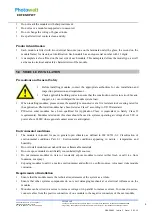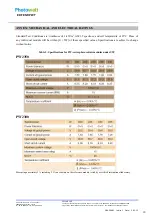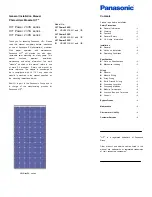
EDF ENR PWT
D06
‐
P06
‐
01
Indice
1
Date:
3
‐
01
‐
13
EDF
ENR
PWT
Société
par
actions
simplifiée
à
associé
unique
–
au
capital
de
37
505
000
€
‐
N°
513
281
972
RCS
NANTERRE
Siège
social
:
100
Esplanade
du
Général
de
Gaulle
–
Cœur
Défense
–
Tour
B
92932
Paris
La
Défense
cedex
.
33,
Rue
Saint
Honoré
‐
Z.I.
Champfleuri
38300
Bourgoin
Jallieu
‐
France
Tel
:
04
74
93
80
20
‐
Fax
:
04
74
93
80
40
Two specific grounding methods are recommended for Photowatt PV modules with 5 mm grounding holes,
as described below. Other grounding methods can be acceptable, provided they comply with all local
electrical codes and regulations.
Method A: Bolt + Nut with teeth + Cup washer.
A grounding kit with M5 size SS cap bolt, M5 size SS flat washer, M5 size SS cup washer, and M5 size SS
nut (with teeth) is used to attach a copper grounding wire to grounding hole on the frame (see picture
above).
Attach the wire between the flat washer and the cup washer. Ensure the cup washer is between the frame
and wire with concave side up to prevent corrosion due to dissimilar metal. Tighten the bolt securely using
the SS nut with teeth. A wrench may be used in this application. The tightening torque is 1 Nm.
Method B: Bolt + K-nut + Ring terminal (copper).
Connect the grounding hardware (M5) to the grounding hole on the
frame as shown in the picture.
A K-nut is used to penetrate anodizing (protective coating) on the
frame to create conductive connection.
A torque moment of about 3 Nm should be used to fasten the
grounding parts to module frame.
Attach wire between the flat
washer and cup washer. Place cup
washer (concave side up) between
frame and wire.
6




























